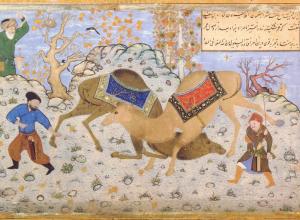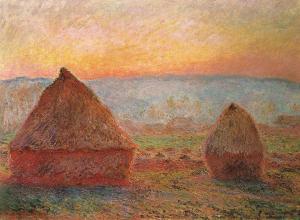
Louis Wain, The Bachelor Party, 1939.
Dogs, horses, even snakes have been favored subjects of artists for centuries, but cats have been more elusive, lurking on the periphery.
All that changed in the late nineteenth century. We can thank Emmy-award-winning actor Benedict Cumberbatch for reigniting interest in the long-forgotten London-born cat artist Louis Wain (1860-1939). Cumberbatch portrays the sad, quirky artist in the 2021 film The Electrical Life of Louis Wain.
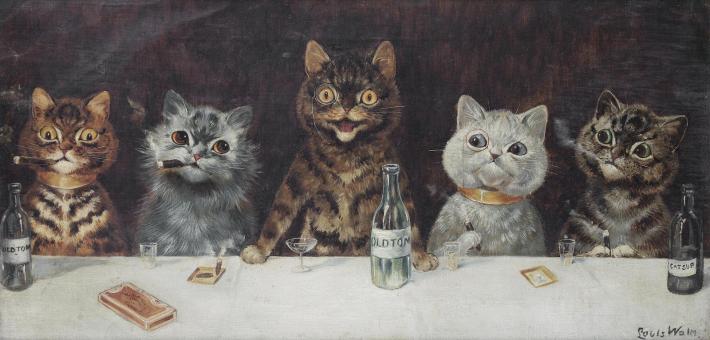
Louis Wain, The Bachelor Party, 1939.
It was Wain’s anthropomorphized drawings of large-eyed cats engaged in activities like playing golf, smoking cigars, or celebrating holidays that became popular in the British press. He was prolific, having illustrated over 100 children’s books. Later in life, his more abstract psychedelic-colored paintings done when he was institutionalized, opened the door for cat lovers everywhere leading to cats playing starring roles in our social media feeds today.

A replica of the lions in the Chauvet Cave (Ardèche, France) housed at Brno museum Anthropos (Czech Republic).
While acknowledging Louis Wain, the subject of cats required a deeper look into the past to unearth their importance to artists. A brief historical overview casts new light on cats as muse going back to the prehistoric Big Cats Chauvet Cave Fresco a monumental work over fifty feet long now a French World Heritage site. These cats are similar to African lions of today and are astounding in the naturalism accomplished by Paleolithic artists over 36,000 years ago.

Box for animal mummy surmounted by a cat, inscribed. Late Period–Ptolemaic Period, 664–30 B.C.
Egyptians made reverence of cats a cult. Cats were mummified, depicted as household pets, or visualized majestically as the God Bastet. In Second Dynasty Egyptian tombs (2890 BCE) Bastet appears as a cat headed female and she also shows up as Ailuros in ancient Greek mythology.

Annibale Carracci, Two Children Teasing a Cat, 1587.
Two Children Teasing a Cat (1587) by the Italian Baroque artist Annibale Carracci (1560-1609) was first attributed to his cousin Ludovico Carracci (1555-1619). Coming from a family of artists, Annibale, along with his brother Agostino (1557-1602) and Ludovico, opened an art school in Bologna where they taught the Carracci style, emphasizing drawing from life. Annibale is known primarily for his religious-themed frescoes making this domestic scene relatively unique in his oeuvre.

Cornelis Visscher, Sleeping Cat, 1657. Etching.
The seventeenth-century Dutch engraver Cornelis Visscher (1629-1658) was considered an excellent draftsman. His Sleeping Cat, a detailed etching done in 1657, hides a clever little mouse in the lower left-hand corner, but we wonder if the cunning cat was just feigning sleep, waiting for the innocent mouse to come close enough to catch.

Jean-Jacques Bachelier, Angora Chasing a Bird, 1761.
Perhaps the most gorgeous cat ever painted is the fluffy white Angora Chasing a Bird (1761) by the French artist Jean-Jacques Bachelier (1724-1806). He was also a ceramicist who served as the director of the famous porcelain factory at Sèvres.
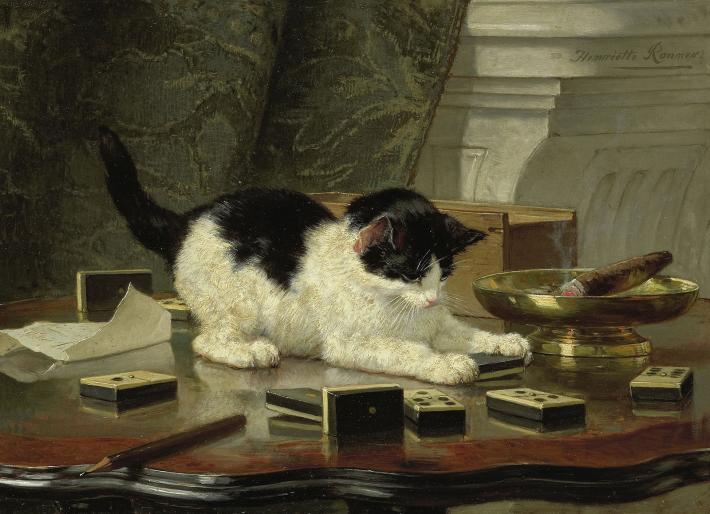
Henriëtte Ronner-Knip, Kitten's Game, c. 1860-78. Rijksmuseum.
The Dutch-Belgian artist Henriëtte Ronner-Knip (1821-1909) was known for animal paintings, specifically cats. She was arguably a much more accomplished artist than Louis Wain, yet he has been credited with bringing viability to cats as aesthetic subject matter.
Like many women artists, Ronner-Knip demonstrated a gift for multi-tasking; raising six children while the popularity of her playful cat paintings among the European bourgeoise earned her the role of breadwinner for her entire family.
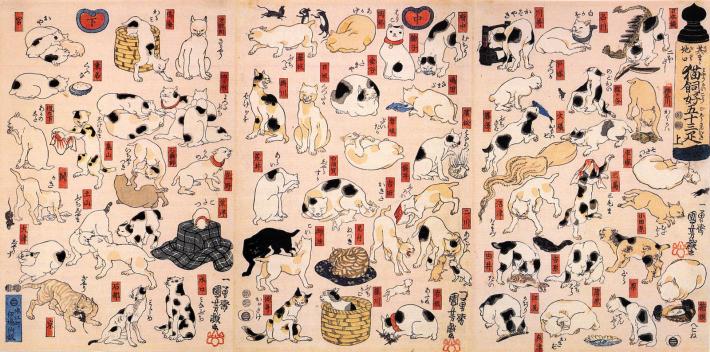
Utagawa Kuniyoshi, Cats Suggested as The Fifty-three Stations of the Tōkaidō', 1850. Wikimedia Commons.
The great Japanese artist Utagawa Kuniyoshi (1798-1861) enshrined beautiful women, landscapes, warriors, and cats in his ukiyo-e style of woodblock prints. He resorted to caricature in his prints and comic pictures (giga) to criticize the elite while avoiding repressive consequences. His Cats Suggested as the Fifty-three Stations of the Tökaidö (1850) serve as a guide showing stopping points offering food and accommodations for travelers along one of Japan’s main routes connecting the historical capital of Edo with the rest of Japan.

Pierre Bonnard, Sitting Woman with a Cat, 1892-98.
Cats pop up frequently among the Impressionists. In Portrait of Julie Manet (1887) Renoir paints a cozy sleeping cat in the lap of the daughter of artist Berthe Morisot and her husband Eugéne Manet, brother of painter Edward. Impressionists and post-Impressionists were also strongly influenced by Japanese prints as seen in Sitting Woman with a Cat (1898) by Pierre Bonnard (1867-1947).

Cover art for I Am a Cat (1906) by Natsue Söseki.
I Am a Cat (1906) by the Japanese novelist Natsue Söseki features an anthropomorphized, talking, domestic cat. It became a wildly popular graphic work that was adapted to film in 1936. A second feature directed by filmmaker Kon Ichikawa (1915-2008) was released in 1975 and in 1982 an anime television special of I Am a Cat premiered in Japan.

Cover art for A Man and His Cat 01 (2018) by Umi Sakurai.
A Man and His Cat is a manga series self-published in 2017 as a web comic by Japanese artist Umi Sakurai. It was bought by a Japanese media company and first aired on TV Tokyo in 2021 as a live-action adaptation featuring cat puppets. Penguin Random House acquired the English rights to the comic and the first volume was released in 2020 with new editions of the series coming in 2022, more evidence that the wily cat always was, and continues to be, a fascinating subject.
Cynthia Close
Cynthia Close holds a MFA from Boston University, was an instructor in drawing and painting, Dean of Admissions at The Art Institute of Boston, founder of ARTWORKS Consulting, and former executive director/president of Documentary Educational Resources, a film company. She was the inaugural art editor for the literary and art journal Mud Season Review. She now writes about art and culture for several publications.





